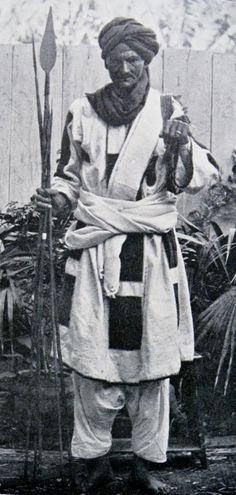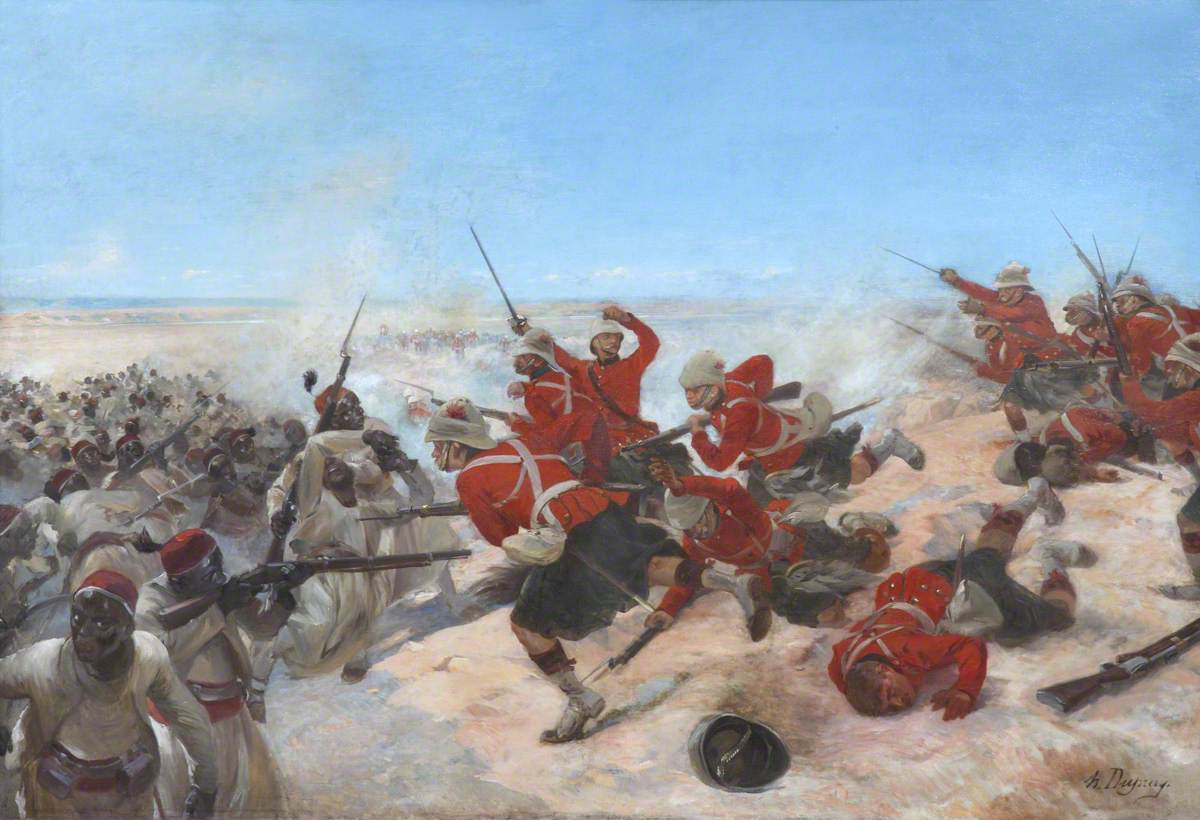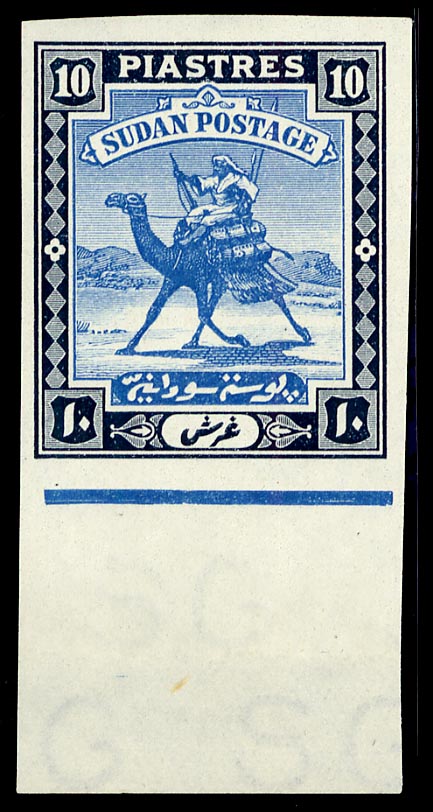|
Battle Of Omdurman (2023)
The Battle of Omdurman was fought during the Anglo-Egyptian conquest of Sudan between a British–Egyptian expeditionary force commanded by British Commander-in-Chief (sirdar) major general Horatio Herbert Kitchener and a Sudanese army of the Mahdist State, led by Abdallahi ibn Muhammad ( the Khalifa), the successor to the self-proclaimed Mahdi, Muhammad Ahmad. The battle took place on 2 September 1898, at Kerreri, north of Omdurman. Following the establishment of the Mahdist State in Sudan, and the subsequent threat to the regional status quo and to British-occupied Egypt, the British government decided to send an expeditionary force with the task of overthrowing the Khalifa. The commander of the force, Sir Herbert Kitchener, was also seeking revenge for the death of General Gordon, who had been killed when a Mahdist army captured Khartoum thirteen years earlier. On the morning of 2 September, some 35,000–50,000 Sudanese tribesmen under Abdullah attacked the British lines ... [...More Info...] [...Related Items...] OR: [Wikipedia] [Google] [Baidu] |
Mahdist War
The Mahdist War ( ar, الثورة المهدية, ath-Thawra al-Mahdiyya; 1881–1899) was a war between the Mahdist Sudanese of the religious leader Muhammad Ahmad bin Abd Allah, who had proclaimed himself the "Mahdi" of Islam (the "Guided One"), and the forces of the Khedivate of Egypt, initially, and later the forces of Britain. Eighteen years of war resulted in the nominally joint-rule state of the Anglo-Egyptian Sudan (1899–1956), a ''de jure'' condominium of the British Empire and the Kingdom of Egypt in which Britain had ''de facto'' control over the Sudan. The Sudanese launched several unsuccessful invasions of their neighbours, expanding the scale of the conflict to include not only Britain and Egypt but also the Italian Empire, the Congo Free State and the Ethiopian Empire. The British participation in the war is called the Sudan campaign. Other names for this war include the Mahdist Revolt, the Anglo–Sudan War and the Sudanese Mahdist Revolt. Background Followi ... [...More Info...] [...Related Items...] OR: [Wikipedia] [Google] [Baidu] |
Charles George Gordon
Major-general (United Kingdom), Major-General Charles George Gordon Companion of the Order of the Bath, CB (28 January 1833 – 26 January 1885), also known as Chinese Gordon, Gordon Pasha, and Gordon of Khartoum, was a British Army officer and administrator. He saw action in the Crimean War as an officer in the British Army. However, he made his military reputation in Qing Dynasty#Rebellion, unrest and external pressure, China, where he was placed in command of the "Ever Victorious Army", a force of Chinese soldiers led by European officers which was instrumental in putting down the Taiping Rebellion, regularly defeating much larger forces. For these accomplishments, he was given the nickname "Chinese Gordon" and honours from both the Emperor of China and the British. He entered the service of the Isma'il Pasha, Khedive of Egypt in 1873 (with British government approval) and later became the List of governors of pre-independence Sudan, Governor-General of the Sudan, where he di ... [...More Info...] [...Related Items...] OR: [Wikipedia] [Google] [Baidu] |
Battle Of El Obeid
The Battle of Shaykan was fought between Anglo-Egyptian forces under the command of Hicks Pasha and forces of Muhammad Ahmad, the self-proclaimed Mahdi, in the woods of Shaykan near Kashgil near the town of El-Obeid on 3–5 November 1883. Background After the Mahdi retreated into Kordofan in 1881 he started to raise an army there and in Darfur. A force of 4,000 was sent to capture him, but it was ambushed near El Obeid and destroyed, and all of its equipment captured. The Mahdi's forces had grown spectacularly, and by 1883 British sources placed their size at 200,000, although that is almost certainly an overestimate. The Egyptian Governor, Rauf Pasha, decided that the only solution to the growing rebellion was a fight, and against the advice of his British advisors started to raise an army of his own. He hired a number of European officers to lead his force, placing them under the command of William "Billy" Hicks, a retired colonel who had experience in India and Abyssinia. ... [...More Info...] [...Related Items...] OR: [Wikipedia] [Google] [Baidu] |
Ansar (Sudan)
The Ansar ( ar, أنصار) is a Sufi religious movement in the Sudan whose followers are disciples of Muhammad Ahmad (12 August 1844 – 22 June 1885), a Sudanese religious leader based on Aba Island, proclaimed himself Mahdi on 29 June 1881. His followers won a series of victories against the Egyptians culminating in the capture of Khartoum in January 1885. When Muhammed Ahmad died a few months later, his successor, Abdallahi ibn Muhammad, maintained the independence of the Mahdist state until 1898, when an Anglo-Egyptian force regained control. The Mahdi's eldest surviving son, Abd al-Rahman al-Mahdi, was the religious and political leader of the Ansar throughout most of the colonial era of the Anglo-Egyptian Sudan (1898–1955) and for a few years after the Sudan gained independence in January 1956. His descendants have led the movement since then. History Mahdiyah Muhammed Ahmad claimed to receive direct inspiration from Allah. After taking power in Sudan between 1883 and 188 ... [...More Info...] [...Related Items...] OR: [Wikipedia] [Google] [Baidu] |
Dervish (Sudan)
The Ansar ( ar, أنصار) is a Sufi religious movement in the Sudan whose followers are disciples of Muhammad Ahmad (12 August 1844 – 22 June 1885), a Sudanese religious leader based on Aba Island, proclaimed himself Mahdi on 29 June 1881. His followers won a series of victories against the Egyptians culminating in the capture of Khartoum in January 1885. When Muhammed Ahmad died a few months later, his successor, Abdallahi ibn Muhammad, maintained the independence of the Mahdist state until 1898, when an Anglo-Egyptian force regained control. The Mahdi's eldest surviving son, Abd al-Rahman al-Mahdi, was the religious and political leader of the Ansar throughout most of the colonial era of the Anglo-Egyptian Sudan (1898–1955) and for a few years after the Sudan gained independence in January 1956. His descendants have led the movement since then. History Mahdiyah Muhammed Ahmad claimed to receive direct inspiration from Allah. After taking power in Sudan between 1883 and ... [...More Info...] [...Related Items...] OR: [Wikipedia] [Google] [Baidu] |
Battle Of Tell El Kebir
The Battle of Tel El Kebir (often spelled Tel-El-Kebir) was fought on 13 September 1882 at Tell El Kebir in Egypt, 110 km north-north-east of Cairo. An entrenched Egyptian force under the command of Ahmed ʻUrabi was defeated by a British army led by Garnet Wolseley, in a sudden assault preceded by a march under cover of darkness. The battle was the decisive engagement of the Anglo-Egyptian War. Background Bombardment and invasion of Alexandria On May 20, 1882, a combined Franco–British fleet arrived at Alexandria. At the same time, Egyptian troops were reinforcing the coastal defenses of the city in anticipation of an attack. These events heightened tension in Alexandria, and eventually triggered tumultuous rioting with loss of life on both sides. As a result of the riots, an ultimatum was sent to the Egyptian government demanding they order Urabi's officers in Alexandria to dismantle their coastal defence batteries. The Egyptian government refused. Meanwhile, ten ... [...More Info...] [...Related Items...] OR: [Wikipedia] [Google] [Baidu] |
British Empire
The British Empire was composed of the dominions, colonies, protectorates, mandates, and other territories ruled or administered by the United Kingdom and its predecessor states. It began with the overseas possessions and trading posts established by England between the late 16th and early 18th centuries. At its height it was the largest empire in history and, for over a century, was the foremost global power. By 1913, the British Empire held sway over 412 million people, of the world population at the time, and by 1920, it covered , of the Earth's total land area. As a result, its constitutional, legal, linguistic, and cultural legacy is widespread. At the peak of its power, it was described as "the empire on which the sun never sets", as the Sun was always shining on at least one of its territories. During the Age of Discovery in the 15th and 16th centuries, Portugal and Spain pioneered European exploration of the globe, and in the process established large overse ... [...More Info...] [...Related Items...] OR: [Wikipedia] [Google] [Baidu] |
Anglo-Egyptian Sudan
Anglo-Egyptian Sudan ( ar, السودان الإنجليزي المصري ') was a condominium of the United Kingdom and Egypt in the Sudans region of northern Africa between 1899 and 1956, corresponding mostly to the territory of present-day Sudan and South Sudan. Legally, sovereignty and administration were shared between both Egypt and the United Kingdom, but in practice the structure of the condominium ensured effective British control over Sudan, with Egypt having limited, local power influence in reality. In the mean time, Egypt itself fell under increasing British influence. Following the Egyptian Revolution of 1952, Egypt pushed for an end to the condominium, and the independence of Sudan. By agreement between Egypt and the United Kingdom in 1953, Sudan was granted independence as the Republic of the Sudan on 1 January 1956. In 2011, the south of Sudan itself became independent as the Republic of South Sudan. In the 19th century, whilst nominally a vassal state of the ... [...More Info...] [...Related Items...] OR: [Wikipedia] [Google] [Baidu] |
Battle Of Umm Diwaykarat
The Battle of Umm Diwaykarat on 25 November 1899 marked the final defeat of the Mahdist State in Sudan, when United Kingdom, Anglo-Egyptian forces under the command of Horatio Kitchener, 1st Earl Kitchener of Khartoum, Lord Kitchener defeated what was left of the Mahdist armies under the command of the Abdallahi ibn Muhammad, known as the Caliph, Khalifa, after the equally disastrous Battle of Omdurman a year earlier. Background After Omdurman, the defeated Mahdist forces, still 25,000 strong, moved southward from Khartoum to Kordofan. The Mahdists still controlled the territory of Kordofan, Darfur, and lands bordering Ethiopia. In October 1899 the British obtained information that the Khalifa and his forces were among his native Baggara to the west of Kosti, Sudan, Kusti (Kaka) in Kordofan. Kitchener dispatched 8,000 Sudanese and Egyptian soldiers under command of General Francis Reginald Wingate, F.R. Wingate to intercept him. Wingate marched from Kusti to the mountains of K ... [...More Info...] [...Related Items...] OR: [Wikipedia] [Google] [Baidu] |
Artillery
Artillery is a class of heavy military ranged weapons that launch munitions far beyond the range and power of infantry firearms. Early artillery development focused on the ability to breach defensive walls and fortifications during sieges, and led to heavy, fairly immobile siege engines. As technology improved, lighter, more mobile field artillery cannons developed for battlefield use. This development continues today; modern self-propelled artillery vehicles are highly mobile weapons of great versatility generally providing the largest share of an army's total firepower. Originally, the word "artillery" referred to any group of soldiers primarily armed with some form of manufactured weapon or armor. Since the introduction of gunpowder and cannon, "artillery" has largely meant cannons, and in contemporary usage, usually refers to shell-firing guns, howitzers, and mortars (collectively called ''barrel artillery'', ''cannon artillery'', ''gun artillery'', or - a layman t ... [...More Info...] [...Related Items...] OR: [Wikipedia] [Google] [Baidu] |
Machine Gun
A machine gun is a fully automatic, rifled autoloading firearm designed for sustained direct fire with rifle cartridges. Other automatic firearms such as automatic shotguns and automatic rifles (including assault rifles and battle rifles) are typically designed more for firing short bursts rather than continuous firepower, and are not considered true machine guns. As a class of military kinetic projectile weapon, machine guns are designed to be mainly used as infantry support weapons and generally used when attached to a bipod or tripod, a fixed mount or a heavy weapons platform for stability against recoils. Many machine guns also use belt feeding and open bolt operation, features not normally found on other infantry firearms. Machine guns can be further categorized as light machine guns, medium machine guns, heavy machine guns, general purpose machine guns and squad automatic weapons. Similar automatic firearms of caliber or more are classified as autocannons, rat ... [...More Info...] [...Related Items...] OR: [Wikipedia] [Google] [Baidu] |
Rifle
A rifle is a long-barreled firearm designed for accurate shooting, with a barrel that has a helical pattern of grooves ( rifling) cut into the bore wall. In keeping with their focus on accuracy, rifles are typically designed to be held with both hands and braced firmly against the shooter's shoulder via a buttstock for stability during shooting. Rifles are used extensively in warfare, law enforcement, hunting, shooting sports, and crime. The term was originally ''rifled gun'', with the verb ''rifle'' referring to the early modern machining process of creating groovings with cutting tools. By the 20th century, the weapon had become so common that the modern noun ''rifle'' is now often used for any long-shaped handheld ranged weapon designed for well-aimed discharge activated by a trigger (e.g., personnel halting and stimulation response rifle, which is actually a laser dazzler). Like all typical firearms, a rifle's projectile (bullet) is propelled by the contained def ... [...More Info...] [...Related Items...] OR: [Wikipedia] [Google] [Baidu] |

.jpg)







